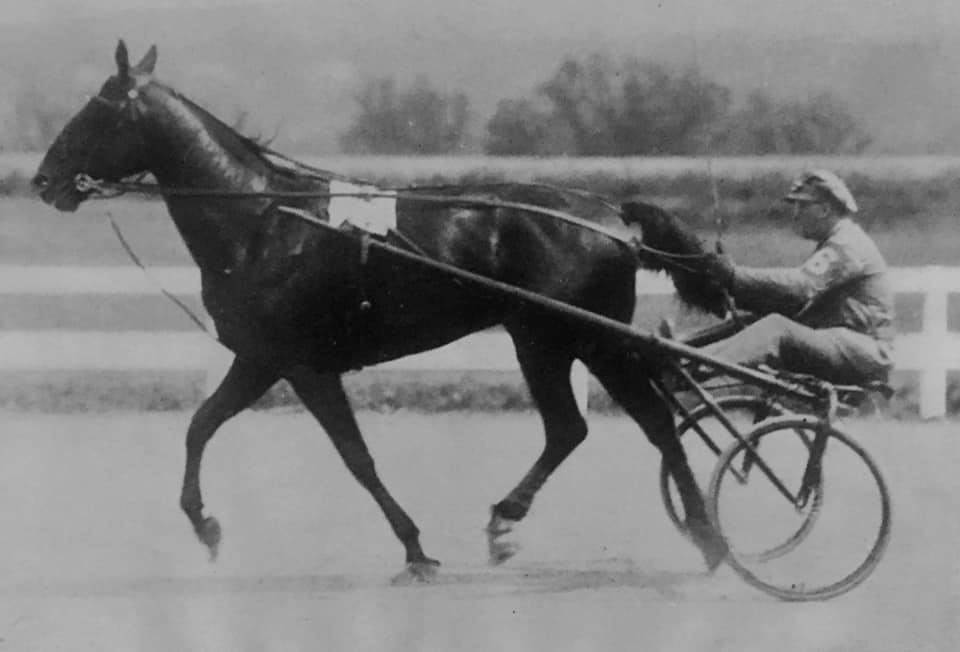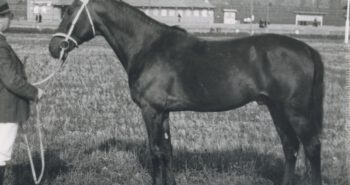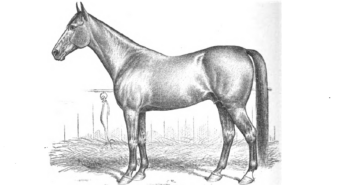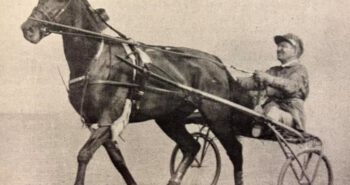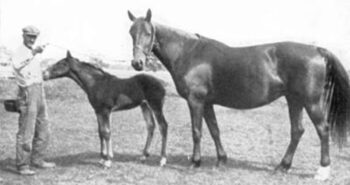The royally-bred colt was not a traditional early talent like many top US trotters. Only at 4 was Peter the Brewer ready to compete at a high level, but then he became an elite trotter in no time and was seen as a likely candidate to be one of the first 2:00 trotters.
Sold as a yearling for $1,350 to JL Sadler of Cleveland at the 25th annual Old Glory Horse Sale in Madison Square Garden in November 1919, Peter the Brewer was then entrusted to trainer William Rosemire. As the colt was “a large, loose, rather ungainly two-year-old”, Rosemire didn’t force him along at all. According to Rosemire, “if Mr. Stadler will not hurry me with this colt he will develop into a great trotter, but he is not the type to do full justice to himself as a two- or three-year-old.” The following year the blue-blooded trotters made the railbirds take notice with some impressive workouts at North Randall, but Peter the Brewer was fortunately allowed to develop at his own rate.
A new owner and trainer
On July 6, 1921, Stadler’s small stable was disposed of in a public auction at North Randall. The three-year-old Peter the Brewer was bought by Edward Stout of Pontiac, MI for $6,000. That Stout shelled out quite a bit for Peter the Brewer was no surprise. A wealthy contractor, he “has picked up one now and then and turned them over to Billy Snow. That driver had a star pacer in gray Zombrewer and Stout admired her so much that when a son of hers was put up he grabbed it.” It wasn’t Snow who got to train Zombrewer’s son, though, as his new owner immediately moved the colt to another trainer at the track, the legendary Nat Ray.
Making his debut in the race for three-year-olds at Columbus at the end of the months, Peter the Brewer finished 3-3-4 whild The Great Volo, a talented full brother to Peter Volo, won all three heats. He then won the first heat of the 2:14 trot at Syracuse on Sep 13 in 2:09 1/4 (1.20,3). Eligible for the Kentucky Futurity, Ray skipped that and opted for the 2:19 trot at Lexington instead, finishing second to Bessie Worthy in both heats.
With only three races under his belt, Peter the Brewer went into winter trainer. Even though he was no longer training the colt, Rosemire’s words would now come true. After a slow start in the seasonal debut at Kalamazoo, where he was fourth in the 2:19 class won by Lee Tide, sire of Spencer, on Jul 21 1922, he then finished second in the 2:11 trot, the Shepard and Swisher stake, at Columbus four days later courtesy of 10-3-2 placings. In the second heat he was timed in 2:04 1/2 (1.17,4), prompting an offer of $25,000, which owner Stout immediately refused.
“The best stake horse I have seen all season“
When the Grand Circuit visited his home track at North Randall on Aug 7, Peter the Brewer was in irresistable form. Winning in 2:06 1/4 and 2:10 1/2 (1.18,5 and 1.21,1), according to one newspaper report “his victory was a clean one. He simply raced his field into the ground. In each mile Peter the Brewer came home well within himself, Nat Ray never having to go to a real drive. In the first heat they went in a bunch to the half at 1:04 1/4. At that point it was anyone’s race. But when the began to step the final half and hit into the wind several of the contenders found the road a rough and weary one. But not so with Peter the Brewer. That colt kept right on and chased by Baron Worthy and Eleanor Guy romped the final half in 1:02. That half, under the conditions, was a remarkable one and certainly indicates that Peter the Brewer has a brilliant future on the trotting turf.”
After a setback in the Bull’s Stake at Philadelphia, where Peter the Brewer was second to the Canadian-born Bill Sharen in all three heats. Going down to the 2:21 class at Poughkeepsie, Peter the Brewer easily won all three heats in 2:08 3/4, 2:09 and 2:09 (1.20,0, 1.20,2 and 1.20,2). Peter the Brewer then narrowly lost three straight heats of The Massachusetts to Czar Worthy at Readville on Aug 31.
Going to Hartford for the $10,000 Charter Oak on Sept 8, Peter the Brewer was then up against the two last trotters to defeat him, Czar Worthy and Bill Sharen. This time there was no denying the four-year-old. From one newspaper article, “The first heat, a heat that brought out a finish between Peter the Brewer and Czar Worthy, brought the most hardener racegoer to this feet as the two thundered to the wire. Czar Worthy broke coming into the stretch in the second heat and Ray finished as he pleased with the Michigan-owned bay, none of the field being able to extend him after Czar Worthy dropped from the front. Rounding the first turn in the final heat Taurida, with Harry Fleming driving, stepped into Ray’s sulky, smashing a wheel to bits and forcing the winning horse from the race, Czar Worthy winning with no trouble all all.” As Peter the Brewer only had to win two heats, the accident in the third heat did not affect the result for him. The victory impressed everybody, and legendary horseman Walter Cox later told the New York Herald that the colt was “the best stake horse I have seen this season”, adding that “he stepped by Czar Worthy and Bill Sharen in the stretch and did not seem all out in doing it.” Cox then regretted not buying the horse himself. “I could have bought him for $20,000 at Columbus and I should have taken him. He may not be as well bred as some of the other Peter the Great’s but he is a sure-fire horse.”
With hindsight, Walter Cox’ comment on Peter the Brewer’s pedigree seem misguided. Zombrewer came from a good family and was the sister of Wilkes Brewer 2:04 1/2 (1.17,4). However, his statement was uttered in 1922, the year before Zombrewer gave birth to Peter the Brewer’s last full sister, Elizabeth. The latter was unstarted but gave the world the incomparable Greyhound as well as Hambletonian-winner Yankee Maid – and the maternal family has since produced several star trotters. In Cox’ defence, though, he couldn’t possibly know this ahead of time.
Tough duels
Six days later Czar Worthy turned the tables on his arch-nemesis, winning all three heats in the $10,000 Empire State, while Peter the Brewer finished 3-2-2 and got second place in the final standings. Peter the Brewer then lowered his record to 2:03 3/4 (1.16,9) when winning the M and M stake at Columbus, easily holding off seven competitors including Bill Sharen. Peter the Brewer and Czar Worthy also met in the Walnut Hall Cup at Lexington on Oct 2, 1922. Peter the Brewer got the best of his arch-nemesis in the first heat when he took down Czar Worthy after a “hot stretch drive.” However, in the second and third heats Walter Cox and The Great Volo got the better of both Peter the Brewer and Czar Worthy.
Just three days later the four-year-old beat the big favorite Great Britton in the Transylvania Trot, coming home strong in both heats to win in 2:02 1/2 (1.16,1), a new record, and 2:03 1/4 (1.16,6). The winning time in the first heat equaled the stake record set by Peter Manning two years prior. It also turned out to be the fastest winning time by a four-year-old on the Grand Circuit in 1922. The win was Peter’s last race of the year and the victory took his annual earnings to $17,297, a handy sum at the time.
Peter the Great’s first 2:00 trotter?
Ahead of the 1923 season, the question was not if Peter the Brewer was one of the top trotters in the country. Instead, the simple question was: can the colt break the two-minute barrier? The public tended to think the trotter could do it: “much interest is shown in the great trotter Peter the Brewer 2:02 1/2. Harness horse exports predict he will be the first two minute horse sired by Peter the Great. Miss Harris M, sired by Peter the Great, has a record of 1:58 1/4 (1.13,5) pacing.” The Dec 13, 1922 edition of Horse Review echoed this view, “it would seem eminently fitting and appropriate to have Peter the Brewer become his sire’s first 2:00 (1.14,6) trotter, for he is owned by an ardent Michigan patron of our sport, Edward Stout, of Pontiac. Peter the Great himself was also, as everyone knows, a Michigan product. It requires no special gift to predict that a horse can trot or pace in 2:00, but in the case of this four-year-old son of Peter one may do so conservatively after taking into consideration all the difficulties the task involves. Peter the Brewer presents the combination which goes with 2:00 capacity; terrific speed, just the right sort of temperament, he being ambitious yet thoroughly good-mannered, and always amenable to the will of his driver; demonstrated gameness; constitutional power, being a strong, sturdy individual; and, what is equally important, he is bred in lines noted both for extreme speed and the ability to carry it.”
Expectations were high ahead of the 1923 season, but the seasonal debut, in the Trotting Sweepstake at North Randall, resulted in a disappointing third place behind The Great Volo and Great Britton. In Toledo on Jul 13 the five-year-old got his revenge when he handsomely defeated both of these, plus Czar Worthy, Lee Worthy and Escotille in three straight heats in The Maumee 2:03 trot. It wasn’t that easy in the 2:03 class, though, and seven days later The Great Volo got his revenge at Kalamazoo after a great duel. According to the Lexington Leader-Herald, “the greatest free-for-all trot ever staked at Recreation Park resulting in the three fastest heats ever trotted over a Michigan track, was raced Friday. The time for the three miles was 2:02 3/4, 2:02 3/4 and 2:03 1/4 (1.16,2, 1.16,2 and 1.16,6).
Great Volo, son of Peter the Great and driven by Walter R Cox, won the first and third heat in desperate contests which Peter the Brewer, another son of Peter the Great, piloted by Egan. Peter the Brewer took the second heat. Each mile was a fight from wire to wire, the field of seven raced in a mass. Great Volo took the first heat by capturing the pole position at the three-quarters and holding it. In the second heat Peter the Brewer finished ahead of him and looked promising for the third mile. The finish of the third mile was sensational. Close to the distance flag, Peter the Brewer appeared a winner, but with a hundred yards to go, Great Volo showed a terrific burst of speed and won by a nose.”
A career ending injury
The story repeated itself at the Dispatch Stake at Columbus with The Great Volo winning the first two in 2:02 1/4 and 2:03 (1.16,0 and 1.16,4), while Peter the Brewer took the third in 2:04 1/2 (1.17,4). “It was a desperately fought battle with only inches separating the two leaders and Czar Worthy being less than a nose behind in the first two miles.” It was more of the same when the Grand Circuit rolled into Windsor, Ontario as Peter the Brewer finished 2-2-2, but this time behind Czar Worthy while The Great Volo slipped to third. Injury prevented the colt from defending his victory in the Charter Oak at Hartford, while the son of Peter the Great was a shadow of himself when he tried to defend his Transylvania Trot title, finishing 5-4 as famous mare Rose Scott swept the two heats.
The injury didn’t let go, and in May 1924 it was reported that the horse “is lame and will not likely race this year.” Ray figured it out, though, and the colt made a surprise return for The Columbus Dispatch Stake at Columbus in July. Considered a long shot, Peter the Brewer pulled off an upset by winning the first two heats in 2:03 1/2 and 2:02 1/2 (1.16,8 and 1.16,1), but pulled up lame after the race. Despite this, two weeks later the colt finished third at Kalamazoo. Then, in late August Peter the Brewer changed hands. Shortly after buying Fairland farm and renaming it Calumet Farms, William M Wright purchased the six-year-old. He turned him over to Dick McMahon in an effort to lower the colt’s record before joining Belwin at the stallion ranks at the new farm – but Peter the Brewer’s injuries didn’t allow for this. Peter the Brewer was no cheap stallion; according to newspaper reports, Monroe paid $25,000 for the horse.
Moving to Hanover
Peter the Brewer stood his first full season in 1925 and bred many of Calumet’s own mares. In September 1933, as Calumet switched from trotters to runners, Peter went into the auction ring at the Kentucky Sales Company. “After spirited bidding, Peter the Brewer, premier sire at Calumet farm and one of the outstanding sires of the standardbred, was purchased by Lawrence B Shepard of Hanover, PA, manager of the Hanover Shoe Farms, for $15,000. The contending bidder was WN Reynolds, of Winston-Salem, NC, owner of Arrow Point farm in Fayette County.” Peter the Brewer then stood stud at Hanover Shoe Farms for the rest of his life.
Peter the Brewer was considered a very good stallion and sired stars like 1933 Hambletonian-winner Mary Reynolds, world champion Calumet Delco and Warwell Worthy, second to Greyhound in the 1935 Hambletonian. Through the latter is also the damsire of Worthy Boy – in addition to Hambletonian-winner Titan Hanover and Little Brown Jug-winner Knight Dream. Through Calumet Delco he established an unofficial sireline in France which has produced several European group 1-winners.
Peter the Brewer died in December 1941. He was elected into the Hall of Fame at Goshen in 1976.
Peter the brewer
Bay colt born in Indianapolis, IN in 1918. Died in Hanover, PA in Dec 1941.
Peter the Great – Zombrewer (Zombro)
2:02 1/2 (1.16,1)
Breeder: Laurel Hall Farm
Owners: Laurel Hall Farm – JL Sadler – Edward Stout – Calumet Farm – Hanover Shoe Farms
Trainers: William Rosemire, Nat Ray and Dick McMahon
Driver: Nat Ray
Groom: –

